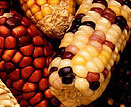 |
 |
|||||||||
|
The Beginning of the Green RevolutionThe University of Minnesota College of Ag, Food and Environemental Sciences After 10 years of wheat breeding, Borlaug had plants that resisted rust and other diseases. Because they were insensitive to the length of daylight, they had the potential to grow in a wide variety of climates. Borlaug had gotten two thirds of the pieces he needed for the science of the green revolution. What was missing was a wheat plant that responded well to fertilizer. To dramatically increase yields grown on Third World lands, drained of nutrients from centuries of farming, fertilizer was required. But traditional wheat varieties, even Borlaug's disease-resistant strains, tended to collapse under heavy fertilization. The extra grains in the head toppled the long, thin stalks. Borlaug searched for a shorter, stronger stalk; in 1961 he found it in a Japanese semi-dwarf variety called Norin. Crossing his hybrid wheat with Norin resulted in disease-resistant, widely adaptable wheat that grew like little bushes. Not only did Norin provide a sturdier stalk, it tillered - sending up multiple stalks from its base. This meant more heads of wheat per plant. And with heavy fertilization, those heads grew fat with grain. By 1963, 95 percent of Mexico's wheat lands grew the new semi-dwarf seeds of the green revolution. The result: a harvest six times the 1944 level, the year Borlaug arrived in Mexico. Even Borlaug had trouble believing the adaptability of the new seed. Test plots around the world began to show similarly dramatic gains in yield. Climates from Sweden to Argentina would prove acceptable to the new seed. Borlaug had more than accomplished the goal of the Mexican project. Mexico was not only self-sufficient in wheat, it had grain to export. Mexican farmers, who a few years earlier didn't know how to use fertilizer, became international seed dealers, supplying the green revolution in other countries. Using the semi-dwarf seed, Pakistan became self-sufficient in wheat within three years. National animosity helped the cause in this case. Pakistan ordered its first big shipment of seed less than a year after its archrival, India, became committed to the green revolution. Between 1965 and 1972 the green revolution more than doubled India's wheat production, making it the third largest producer in the world. Side benefits included new fertilizer plants and tractor factories. In one year, village cooperatives sand 200,000 wells to tap India's plentiful groundwater. The revolution needed trained workers, and Borlaug proposed a training program "in the new aggressive approach to modern agronomy." More than 20 nations sent young agronomists to Borlaug's program in Mexico. Politics made no difference in this revolution. Russians learned along with Poles, Israelis along with Turks. To make sure his "wheat apostles," as they were sometimes called, had the right stuff, Borlaug would start them with back-bending labor 12 hours a day in the fields. It was common for young agronomists from developing countries to view themselves as an elite. They much preferred the idea of writing reports in air-conditioned offices to working with sweating peasant farmers. Borlaug's first young Mexican assistants insisted on wearing suits into the fields. The tasks Borlaug set them quickly turned the suits into rags. Khaki work clothes and baseball caps became the uniform of the green revolutionaries. While working like the small farmers they were to help, they learned Borlaug's techniques for fertilization, wheat breeding, and soil analysis.
|
|